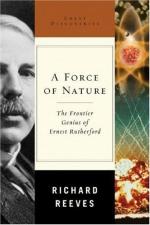|
This section contains 2,248 words (approx. 8 pages at 300 words per page) |

|
World of Chemistry on Ernest Rutherford
Ernest Rutherford's explanation of radioactivity earned him the 1908 Nobel Prize in chemistry, but his most renowned achievement was his classic demonstration that the atom consists of a small, dense nucleus surrounded by orbiting electrons. He also demonstrated the transmutation of one element into another by splitting the atom. His direction of laboratories in Canada and Great Britain led to such triumphs as the discovery of the neutron and helped to launch high-energy, or particle, physics, which concentrates on the constitution, properties, and interactions of elementary particles of matter.
Rutherford was born the fourth of twelve children on August 30, 1871, to James and Martha Thompson Rutherford on the South Island of New Zealand near the village of Spring Grove. Both parents had arrived in New Zealand as children, not long after Great Britain annexed the territory into the Commonwealth in 1840. Rutherford's father, of Scottish descent, logged, cultivated flax, worked in...
|
This section contains 2,248 words (approx. 8 pages at 300 words per page) |

|


